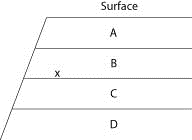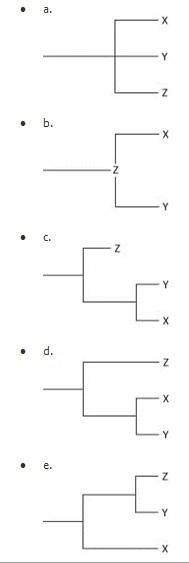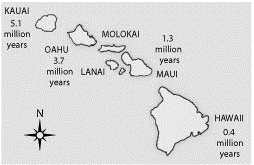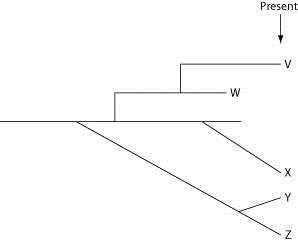Question 1
Over time, the movement of people on Earth has steadily increased. This has altered the course of human evolution by increasing
• a. nonrandom mating.
• b. gene flow.
• c. genetic drift.
• d. geographic isolation.
b.
Question 2
Which of the following is a true statement concerning genetic variation?
• a. A population that has a higher average heterozygosity has less genetic variation than one with a lower average heterozygosity.
• b. It arises in response to changes in the environment.
• c. It tends to be reduced by the processes involved when diploid organisms produce gametes.
• d. It is created by the direct action of natural selection.
• e. It must be present in a population before natural selection can act upon the population.
e.
Question 3
In a Hardy-Weinberg population with two alleles, A and a, that are in equilibrium, the frequency of the allele a is 0.3. What is the percentage of the population that is homozygous for this allele?
• a. 0.49
• b. 49.0
• c. 0.09
• d. 9.0
• e. 0.9
d.
Question 4
Which of the following must exist in a population before natural selection can act upon that population?
• a. sexual reproduction
• b. genetic variation among individuals
• c. variation among individuals caused by environmental factors
• d. Three of the responses are correct.
• e. Two of the responses are correct.
b.
Question 5
Which of the following statements best describes theories?
• a. They are predictions of future events.
• b. They are supported by, and make sense of, many observations.
• c. They cannot be tested because the described events occurred only once.
• d. They are nearly the same things as hypotheses.
b.
Question 6
Which of the following statements best summarizes evolution as it is viewed today?
• a. It is the differential survival and reproduction of the most-fit phenotypes.
• b. It is synonymous with the process of gene flow.
• c. It is the descent of humans from the present-day great apes.
• d. It represents the result of selection for acquired characteristics.
a.
Question 7
If one wanted to find the largest number of endemic species, one should visit which of the following geological features (assuming each has existed for several millions of years)?
• a. a shallow estuary on a warm-water coast
• b. an isolated ocean island in the tropics
• c. an extensive mountain range
• d. a midcontinental grassland with extreme climatic conditions
b.
Question 8
A trend toward the decrease in the size of plants on the slopes of mountains as altitudes increase is an example of
• a. a cline.
• b. genetic drift.
• c. relative fitness.
• d. geographic variation.
• e. a bottleneck.
a.
Question 9
Ichthyosaurs were aquatic dinosaurs. Fossils show us that they had dorsal fins and tails, as do fish, even though their closest relatives were terrestrial reptiles that had neither dorsal fins nor aquatic tails. The dorsal fins and tails of ichthyosaurs and fish are
• a. examples of convergent evolution.
• b. homologous.
• c. adaptations to a common environment.
• d. Three of the responses above are correct.
• e. Two of the responses above are correct.
e.
Question 10
Sparrows with average-sized wings survive severe storms better than those with longer or shorter wings, illustrating
• a. frequency-dependent selection.
• b. stabilizing selection.
• c. disruptive selection.
• d. the bottleneck effect.
• e. neutral variation.
b.
Question 11
The recessive allele that causes phenylketonuria (PKU) is harmful, except when an infant's diet lacks the amino acid phenylalanine. What maintains the presence of this harmful allele in a population's gene pool?
• a. stabilizing selection
• b. diploidy
• c. balancing selection
• d. heterozygote advantage
b.
Question 12
In the mid-1900s, the Soviet geneticist Lysenko believed that his winter wheat plants, exposed to ever-colder temperatures, would eventually give rise to ever more cold-tolerant winter wheat. Lysenko's attempts in this regard were most in agreement with the ideas of
• a. Lamarck.
• b. Cuvier.
• c. Darwin.
• d. Lyell.
• e. Hutton.
a.
Question 13
With what other idea of his time was Cuvier's theory of catastrophism most in conflict?
• a. the fixity of species
• b. island biogeography
• c. the scala naturae
• d. gradualism
• e. uniformitarianism
e.
Question 14
No two people are genetically identical, except for identical twins. The main source of genetic variation among human individuals is
• a. environmental effects.
• b. the reshuffling of alleles in sexual reproduction.
• c. new mutations that occurred in the preceding generation.
• d. genetic drift due to the small size of the population.
• e. geographic variation within the population.
b.
Question 15
Evolution
• a. must happen whenever a population is not well-adapted to its environment.
• b. must happen, due to organisms’ innate desire to survive.
• c. requires the operation of natural selection.
• d. can happen whenever any of the conditions for Hardy-Weinberg equilibrium are not met.
• e. requires that populations become better suited to their environments.
d.

Question 16
The following questions refer to Figure 22.1, which shows an outcrop of sedimentary rock whose strata are labeled A D.
Figure 22.1
Currently, two extant (currently exisitng) elephant species (X and Y) are placed in the genus Loxodonta and a third extant species (Z) is placed in the genus Elephas. Assuming this classification reflects evolutionary relatedness, which of the following is the most accurate phylogenetic tree?
• a.
• b.
• c.
• d.
• e.

d
Question 17
Given a population that contains genetic variation, what is the correct sequence of the following events, under the influence of natural selection?
1. Well-adapted individuals leave more offspring than do poorly adapted individuals.
2. A change occurs in the environment.
3. Genetic frequencies within the population change.
4. Poorly adapted individuals have decreased survivorship.
• b. 4 → 2 → 3 → 1
• c. 2 → 4 → 3 → 1
• d. 4 → 2 → 1 → 3
• e. 4 → 1 → 2 → 3
a.
Question 18
Which statement about the beak size of finches on the island of Daphne Major during prolonged drought is true?
• a. Each bird's survival was strongly influenced by the depth and strength of its beak as the drought persisted.
• b. Each bird that survived the drought produced only offspring with deeper, stronger beaks than seen in the previous generation.
• c. The frequency of the strong-beak alleles increased in each bird as the drought persisted.
• d. Each bird evolved a deeper, stronger beak as the drought persisted.
a.
Question 19
Of the following anatomical structures, which is homologous to the bones in the wing of a bird?
• a. bones in the flipper of a whale
• b. bones in the hind limb of a kangaroo
• c. chitinous struts in the wing of a butterfly
• d. cartilage in the dorsal fin of a shark
• e. bony rays in the tail fin of a flying fish
a.
Question 20
Which of the following is most likely to produce an African butterfly species in the wild whose members have one of two strikingly different color patterns?
• a. sexual selection
• b. stabilizing selection
• c. directional selection
• d. disruptive selection
• e. artificial selection
d.
Question 21
In the formula for determining a population's genotype frequencies, the 2 in the term 2pq is necessary because (recall Hardy-Weinberg formula as: p2 + 2pq + q2 = 1)
• a. heterozygotes have two alleles.
• b. heterozygotes can come about in two ways.
• c. the population is doubling in number.
• d. the population is diploid.
b.
Question 22
Natural selection changes allele frequencies because some ________ survive and reproduce more successfully than others.
• a. gene pools
• b. loci
• c. species
• d. individuals
• e. alleles
d.
Question 23
A proficient engineer can easily design skeletal structures that are more functional than those currently found in the forelimbs of such diverse mammals as horses, whales, and bats. The actual forelimbs of these mammals do not seem to be optimally arranged because
• a. natural selection has not had sufficient time to create the optimal design in each case, but will do so given enough time.
• b. natural selection is generally limited to modifying structures that were present in previous generations and in previous species.
• c. in many cases, phenotype is not merely determined by genotype, but by the environment as well.
• d. though we may not consider the fit between the current skeletal arrangements and their functions excellent, we should not doubt that natural selection ultimately produces the best design.
b.
Question 24
Although each of the following has a better chance of influencing gene frequencies in small populations than in large populations, which one most consistently requires a small population as a precondition for its occurrence?
• a. nonrandom mating
• b. natural selection
• c. genetic drift
• d. mutation
• e. gene flow
c.
Question 25
Charles Darwin was the first person to propose
• a. that population growth can outpace the growth of food resources.
• b. that Earth is older than a few thousand years.
• c. a mechanism for how evolution occurs.
• d. that evolution occurs.
• e. a mechanism for evolution that was supported by evidence.
e.
Question 1
Adaptive radiations can be a direct consequence of four of the following five factors. Select the exception.
a. an adaptive radiation in a group of organisms (such as plants) that another group uses as food
b. evolutionary innovation
c. genetic drift
d. colonization of an isolated region that contains suitable habitat and few competitor species
e. vacant ecological niches
a.
Question 2
Males of different species of the fruit fly Drosophila that live in the same parts of the Hawaiian Islands have different elaborate courtship rituals. These rituals involve fighting other males and making stylized movements that attract females. What type of reproductive isolation does this represent?
a. gametic isolation
b. temporal isolation
c. habitat isolation
d. postzygotic barriers
e. behavioral isolation
e.
Question 3
How many of the following statements concerning the loss of hind limbs during whale evolution are true?
1. It is well documented by a series of transitional fossils.
2. It explains why modern whales have vestigial pelvic girdles.
3. It involved changes in the sequence or expression of Hox genes.
4. It is an example of macroevolution.
5. It, and the loss of limbs by snakes, are an example of similar adaptations to a similar environment.
a. Only one statement is true.
b. Two statements are true.
c. Three statements are true.
d. Four statements are true.
e. All five statements are true.
d.
Question 4
Approximately how far back in time does the fossil record extend?
a. 5.0 million years
b. 3.5 billion years
c. 3.5 million years
d. 5.0 billion years
b.
Question 5
Speciation
a. and microevolution are synonymous.
b. must begin with the geographic isolation of a small, frontier population.
c. can involve changes to a single gene.
d. occurs only by the accumulation of genetic change over vast expanses of time.
e. occurs at such a slow pace that no one has ever observed the emergence of new species.
c.
Question 6
What is true of macroevolution?
a. It is defined as the evolution of microscopic organisms into organisms that can be seen with the naked eye.
b. It is defined as a change in allele or gene frequency over the course of many generations.
c. It is the conceptual link between irritability and adaptation.
d. It is evolution above the species level.
e. It is the same as microevolution, but includes the origin of new species.
d.
Question 7
Rocky Mountain juniper (Juniperus scopulorum) and one-seeded juniper (J. monosperma) have overlapping ranges. If pollen grains (which contain sperm cells) from one species are unable to germinate and make pollen tubes on female ovules (which contain egg cells) of the other species, then which of these terms is applicable?
a. reduced hybrid viability
b. behavioral isolation
c. hybrid breakdown
d. mechanical isolation
d.
Question 8
If the half-life of carbon-14 is about 5,730 years, then a fossil that has one-sixteenth the normal proportion of carbon-14 to carbon-12 should be about how many years old?
a. 22,900
b. 2,800
c. 1,400
d. 11,200
e. 16,800
a.

Soon after the island of Hawaii rose above the sea surface (somewhat less than 1 million years ago), the evolution of life on this new island should have been most strongly influenced by
a. sexual selection.
b. genetic bottleneck.
c. habitat differentiation.
d. founder effect.
d.

Question 10
The next few questions refer to the following evolutionary tree, whose horizontal axis represents time (present time is on the far right) and whose vertical axis represents morphological change.
Which species is most closely related to species W?
a. V is most closely related to species W.
b. Y and Z are equally closely related to W.
c. X is most closely related to species W.
d. It is not possible to say from this tree.
a.
Question 11
The first terrestrial organisms probably were considered which of the following?
1. burrowers
2. photosynthetic
3. multicellular
4. prokaryotes
5. eukaryotes
6. plants and their associated fungi
a. 1, 3, and 5
b. 3 and 5
c. 2 and 4
d. 2, 3, and 6
e. 2, 3, 5, and 6
c.
Question 12
A swim bladder is a gas-filled sac that helps fish maintain buoyancy. The evolution of the swim bladder from lungs of an ancestral fish is an example of
a. paedomorphosis.
b. an evolutionary trend.
c. changes in Hox gene expression.
d. exaptation.
e. adaptive radiation.
d.
Question 13
The most likely explanation for the high rate of sympatric speciation that apparently existed among the cichlids of Lake Victoria in the past is
a. introduction of a new predator.
b. habitat differentiation.
c. pollution.
d. sexual selection.
e. polyploidy.
d.
Question 14
Which of these observations gives the most support to the endosymbiotic theory for the origin of eukaryotic cells?
a. the existence of structural and molecular differences between the plasma membranes of prokaryotes and the internal membranes of mitochondria and chloroplasts
b. the size disparity between most prokaryotic cells and most eukaryotic cells
c. the similarity in size between the cytosolic ribosomes of prokaryotes and the ribosomes within mitochondria and chloroplasts
d. the observation that some eukaryotic cells lack mitochondria
c.
Question 15
An early consequence of the release of oxygen gas by plant and bacterial photosynthesis was to
a. cause iron in ocean water and terrestrial rocks to rust (oxidize).
b. change the atmosphere from oxidizing to reducing.
c. make it easier to maintain reduced molecules.
d. prevent the formation of an ozone layer.
e. generate intense lightning storms.
a.
Question 16
A hybrid zone is properly defined as
a. a zone that includes the intermediate portion of a cline.
b. an area where two closely related species' ranges overlap.
c. an area where mating occurs between members of two closely related species, producing viable offspring.
d. a zone that features a gradual change in species composition where two neighboring ecosystems border each other.
e. an area where members of two closely related species intermingle, but experience no gene flow.
c.
Question 17
Fossilized stromatolites
a. all date from 2.7 billion years ago.
b. resemble structures formed by bacterial communities that are found today in some warm, shallow, salty bays.
c. contain the first undisputed fossils of eukaryotes and date from 2.1 billion years ago.
d. formed around deep-sea vents.
e. provide evidence that plants moved onto land in the company of fungi around 500 million years ago.
b.
Question 18
You are confronted with a box of preserved grasshoppers of various species that are new to science and have not been described. Your assignment is to separate them into species. There is no accompanying information as to where or when they were collected. Which species concept will you have to use?
a. phylogenetic
b. ecological
c. morphological
d.biological
c.
Question 19
Which of the following is the correct sequence of events in the origin of life?
I. formation of protobionts
II. synthesis of organic monomers
III. synthesis of organic polymers
IV. formation of DNA-based genetic systems
a. II, III, IV, I
b. II, III, I, IV
c. I, II, III, IV
d. I, III, II, IV
b.
Question 20
Which of the following statements about species, as defined by the biological species concept, is (are) correct?
I. Biological species are defined by reproductive isolation.
II. Biological species are the model used for grouping extinct forms of life.
III. The biological species is the largest unit of population in which successful interbreeding is possible.
a. I and II
b. I and III
c. II and III
d. I, II, and III
b.